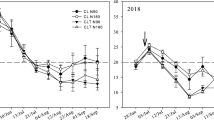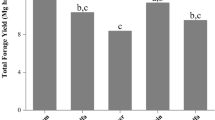Abstract
Diversification of monoculture grass pastures may provide opportunity for increased productivity, efficiency, and sustainability of forage-livestock systems. Our objective was to compare herbage accumulation (HA), nutritive value, and animal performance on a grass monoculture control and two alternative systems, all based on ‘Marandu’ palisadegrass [Brachiaria (syn. Urochloa) brizantha (A. Rich.) Stapf] in the Amazon Biome. Alternatives were a crop-livestock system based on soybean [Glycine max (L.) Merr.] and palisadegrass, and a eucalyptus [Eucalyptus urograndis (hybrid of E. grandis W. Hill ex Maiden and E. urophylla S. T. Blake) clone H13]-palisadegrass silvopasture. From July 2017 to May 2018 all experimental units were stocked continuously with beef cattle using a variable stocking rate to maintain a palisadegrass canopy height of 30 cm. The grass monoculture and silvopasture systems had similar HA (13,200 kg dry matter [DM] ha−1) and herbage accumulation rate (HAR; 40 kg DM ha−1 day−1), whereas crop-livestock resulted in greater HA (127%) and HAR (158%) than the other systems. Animal weight gain ha−1 for crop-livestock was 860 kg, 15% greater than for grass monoculture and silvopasture systems (average of 750 kg). Greatest palisadegrass HA and animal performance following 2 years of soybean production support the crop-livestock as an alternative for sustainable intensification. The similar HA and gain ha−1 in the seventh year of the silvopasture and grass monoculture indicates tree-pastures systems need wider arrangements to warrant long-term productivity. The maintenance of soil fertility, appropriate grazing management, and animal nutritional supplementation can greatly improve forage-based systems in the Amazon Biome.


Similar content being viewed by others
References
Adewopo JB, Silveira ML, Xu S et al (2014) Management intensification impacts on soil and ecosystem carbon stocks in subtropical grasslands. Soil Sci Soc Am J 78:977–986. https://doi.org/10.2136/sssaj2013.12.0523
Alvares CA, Stape JL, Sentelhas PC et al (2013) Köppen’s climate classification map for Brazil. Meteorol Zeitschrift 22:711–728. https://doi.org/10.1127/0941-2948/2013/0507
AOAC (1990) Official methods of analysis, 15th edn. Association of Official Analytical Chemists, Virginia
Barthram GT (1985) Experimental techniques: the HFRO sward stick. Hill Farming Res Organ Rep 1984/1985, pp 29–30
Bourscheidt MLB, Pedreira BC, Pereira DH et al (2019) Nitrogen input strategies in pastures: mineral fertilizer, bacterial inoculant and consortium with forage peanuts. Sci Electron Arch 12:137–147. https://doi.org/10.36560/1232019784
Carvalho PCF, Anghinoni I, de Moraes A et al (2010) Managing grazing animals to achieve nutrient cycling and soil improvement in no-till integrated systems. Nutr Cycl Agroecosystems 88:259–273. https://doi.org/10.1007/s10705-010-9360-x
Carvalho P, Domiciano LF, Mombach MA et al (2019) Forage and animal production on palisadegrass pastures growing in monoculture or as a component of integrated crop–livestock–forestry systems. Grass Forage Sci 74:650–660. https://doi.org/10.1111/gfs.12448
Costa MP, Schoeneboom JC, Oliveira SA et al (2018) A socio-eco-efficiency analysis of integrated and non-integrated crop-livestock-forestry systems in the Brazilian Cerrado based on LCA. J Clean Prod 171:1460–1471. https://doi.org/10.1016/j.jclepro.2017.10.063
Costa NR, Andreotti M, Mascarenhas Lopes KS et al (2015) Atributos do solo e acúmulo de carbono na integração lavoura-pecuária em sistema plantio direto. Rev Bras Cienc do Solo 39:852–863. https://doi.org/10.1590/01000683rbcs20140269
Da Silva SC, Pereira LET, Sbrissia AF, Hernandez-Garay A (2014) Carbon and nitrogen reserves in marandu palisade grass subjected to intensities of continuous stocking management. J Agric Sci 153:1449–1463. https://doi.org/10.1017/S0021859614001130
Domiciano LF, Mombach MA, Carvalho P et al (2018) Performance and behaviour of Nellore steers on integrated systems. Anim Prod Sci 58:920. https://doi.org/10.1071/AN16351
Domiciano LF, Pedreira BC, Silva NMF da, et al (2020) Agroforestry systems: an alternative to intensify forage-based livestock in the Brazilian Amazon. Agrofor Syst X:1–11. doi: 10.1007/s10457–020–00499–1
Embrapa (2018) Weather Station (Estação Meteorológica). In: Embrapa Agrossilvipastoril
Euclides VPB, Montagner DB, Barbosa RA et al (2016) Animal performance and sward characteristics of two cultivars of Brachiaria brizantha (BRS Paiaguás and BRS Piatã). Rev Bras Zootec 45:85–92. https://doi.org/10.1590/S1806-92902016000300001
Gomes FJ, Pedreira BC, Santos PM et al (2020) Microclimate effects on canopy characteristics of shaded palisadegrass pastures in a silvopastoral system in the Amazon biome of central Brazil. Eur J Agron 115:126029. https://doi.org/10.1016/j.eja.2020.126029
Gomes FJ, Pedreira CGS, Bosi C et al (2019) Shading effects on Marandu palisadegrass in a silvopastoral system: plant morphological and physiological responses. Agron J 111:1–9. https://doi.org/10.2134/agronj2019.01.0052
Herling VR, Pedreira CGS, De PH et al (2011) Performance and productivity of Nellore steers on rotationally stocked palisadegrass (Brachiaria brizantha) pastures in response to herbage allowance. J Agric Sci 149:761–768. https://doi.org/10.1017/S0021859611000116
Hernández Garay A, Sollenberger LE, McDonald DC et al (2004) Nitrogen fertilization and stocking rate affect stargrass pasture and cattle performance. Crop Sci 44:1348–1354. https://doi.org/10.2135/cropsci2004.1348
Johnson SE, Sollenberger LE, Bennett JM (1994) Yield and reserve status of rhizoma peanut growing under shade. Crop Sci 34:757–761. https://doi.org/10.2135/cropsci1994.0011183X003400030028x
Klingman DL, Miles SR, Mott GO (1943) The cage method for determining consumption and yield of pasture herbage. J Am Soc Agron 35:739–746
Lazzarini I, Detmann E, Sampaio CB et al (2009) Transit and degradation dynamics of neutral detergent fiber in cattle fed low-quality tropical forage and nitrogenous compounds (Portuguese). Arq Bras Med Veterinária e Zootec 61:635–647. https://doi.org/10.1590/S0102-09352009000300017
Lima MA, Paciullo DSC, Morenz MJF et al (2019) Productivity and nutritive value of Brachiaria decumbens and performance of dairy heifers in a long-term silvopastoral system. Grass Forage Sci 74:160–170. https://doi.org/10.1111/gfs.12395
Littell RC, Milliken GA, Stroup WW et al (2006) SAS for mixed model, 2nd edn. SAS Publishing, Cary
Magalhães CAS, Pedreira BC, Tonini H, Farias Neto AL (2019) Crop, livestock and forestry performance assessment under different production systems in the north of Mato Grosso, Brazil. Agrofor Syst 93:2085–2096. https://doi.org/10.1007/s10457-018-0311-x
McCartor MM, Rouquette FM (1977) Grazing pressures and animal performance from pearl millet. Agron J 69:983. https://doi.org/10.2134/agronj1977.00021962006900060020x
Minson DJ (1990) Forage in ruminant nutrition. Academic Press, San Diego
Mott GO, Lucas HL (1952) The design, conduct and interpretation of grazing trials on cultivated and improved pastures. In: IGC, Proceedings of the 6th International Grassland Congress. State College Press, Pennsylvania, pp 1380–1395
Nascimento HLB, Pedreira BC, Sollenberger LE et al (2019) Physiological characteristics and forage accumulation of grazed Marandu palisade grass (Brachiaria brizantha) growing in monoculture and in silvopasture with Eucalyptus urograndis. Crop Pasture Sci 70:384–394. https://doi.org/10.1071/CP18403
Nave RLG, Pedreira CGS, Pedreira BC (2011) Nutritive value and physical characteristics of Xaraes palisadegrass as affected by grazing strategy. S Afr J Anim Sci 40:285–293. https://doi.org/10.4314/sajas.v40i4.65236
OECD-FAO (2015) OCDE-FAO Perspectivas Agrícolas 2015–2024 (OECD-FAO Agricultural Outlook 2015–2024). OECD Publishing, Paris
Paciullo DSC, Castro CRT, Gomide CAM et al (2011) Performance of dairy heifers in a silvopastoral system. Livest Sci 141:166–172. https://doi.org/10.1016/j.livsci.2011.05.012
Pedreira BC, Domiciano LF, Vilela L et al (2018) O estado da arte e estudos de caso em sistemas integrados de produção agropecuária no Centro-Oeste do Brasil. In: de Souza ED, da Silva FD, Assmann TS, et al. (eds) Sistemas Integrados de Produção Agropecuária no Brasil, 1st edn. Copiart, Tubarão, pp 277–300
Pedreira CGS, Silva VJ, Pedreira BC, Sollenberger LE (2017) Herbage accumulation and organic reserves of palisadegrass in response to grazing management based on canopy targets. Crop Sci 57:2283. https://doi.org/10.2135/cropsci2016.11.0957
Peri PL, Lucas RJ, Moot DJ (2007) Dry matter production, morphology and nutritive value of Dactylis glomerata growing under different light regimes. Agrofor Syst 70:63–79. https://doi.org/10.1007/s10457-007-9029-x
Petersen RG, Lucas HL (1968) Computing methods for the evaluation of pastures by means of animal response. Agron J 60:682–687. https://doi.org/10.2134/agronj1968.00021962006000060031x
Reis JC dos, Kamoi MYT, Michetti M, Wruck FJ (2018) Análise dos benefícios econômicos da diversificação da produção em sistemas de integração lavoura-pecuáriafloresta. In: 56° Congresso da Sociedade Brasileira de Economia, Administração e Sociologia Rural - SOBER. Congresso da Sociedade Brasileira de Economia, Administração e Sociologia Rural, Campinas, SP
Salton JC, Mercante FM, Tomazi M et al (2014) Integrated crop-livestock system in tropical Brazil: toward a sustainable production system. Agric Ecosyst Environ 190:70–79. https://doi.org/10.1016/j.agee.2013.09.023
Santos DC, Guimarães Júnior R, Vilela L et al (2016) Forage dry mass accumulation and structural characteristics of Piatã grass in silvopastoral systems in the Brazilian savannah. Agric Ecosyst Environ 233:16–24. https://doi.org/10.1016/j.agee.2016.08.026
Soil Survey Staff (2014) Keys to soil taxonomy by soil, 12th edn. USDA - Natural Resources Conservation Service, Washington
Sollenberger LE, Kohmann MM, Dubeux JCB, Silveira ML (2019) Grassland management affects delivery of regulating and supporting ecosystem services. Crop Sci 59:1–19. https://doi.org/10.2135/cropsci2018.09.0594
Sollenberger LE, Moore JE, Allen VG, Pedreira CGS (2005) Reporting forage allowance in grazing experiments. Crop Sci 45:896–900. https://doi.org/10.2135/cropsci2004.0216
Sollenberger LE, Vanzant ES (2011) Interrelationships among forage nutritive value and quantity and individual animal performance. Crop Sci 51:420–432. https://doi.org/10.2135/cropsci2010.07.0408
Valladares F, Niinemets Ü (2008) Shade tolerance, a key plant feature of complex nature and consequences. Annu Rev Ecol Evol Syst 39:237–257. https://doi.org/10.1146/annurev.ecolsys.39.110707.173506
Van Soest PJ, Robertson JB, Lewis BA (1991) Methods for dietary fiber, neutral detergent fiber, and nonstarch polysaccharides in relation to animal nutrition. J Dairy Sci 74:3583–3597. https://doi.org/10.3168/jds.s0022-0302(91)78551-2
Vendramini JMB, Sollenberger LE, Dubeux JCB et al (2007) Concentrate supplementation effects on the performance of early weaned calves grazing Tifton 85 bermudagrass. Agron J 99:399–404. https://doi.org/10.2134/agronj2005.0355
Wolfinger R (1993) Covariance structure selection in general mixed models. Commun Stat Simul Comput 22:1079–1106. https://doi.org/10.1080/03610919308813143
Zen S de, Moreira R, Gomes M, Penazzi G (2018) Em 10 anos, produtividade média da pecuária nacional cresce mais de 22%. Bol Ativos da Pecuária Corte 10:1–5. https://www.cnabrasil.org.br/boletins
Acknowledgements
This work was supported by CNPq [479409/2013-7 and 303438/2015-0]; Embrapa [Grant Numbers 02.16.05.007.00.00]; Acrimat and ICLF Network. The authors acknowledge CAPES (Coordenação de Aperfeiçoamento de Pessoal de Nível Superior, Brazil) [Finance Code 001] and FAPEMAT for granting a scholarship to the first author; and Acrinorte for the partnership with the beef cattle used [44.771/14 and 50.168/2017].
Author information
Authors and Affiliations
Corresponding author
Ethics declarations
Conflicts of interest
The authors declare no conflicts of interest.
Additional information
Publisher's Note
Springer Nature remains neutral with regard to jurisdictional claims in published maps and institutional affiliations.
Rights and permissions
About this article
Cite this article
da Silva, F.S., Domiciano, L.F., Gomes, F.J. et al. Herbage accumulation, nutritive value and beef cattle production on marandu palisadegrass pastures in integrated systems. Agroforest Syst 94, 1891–1902 (2020). https://doi.org/10.1007/s10457-020-00508-3
Received:
Accepted:
Published:
Issue Date:
DOI: https://doi.org/10.1007/s10457-020-00508-3




